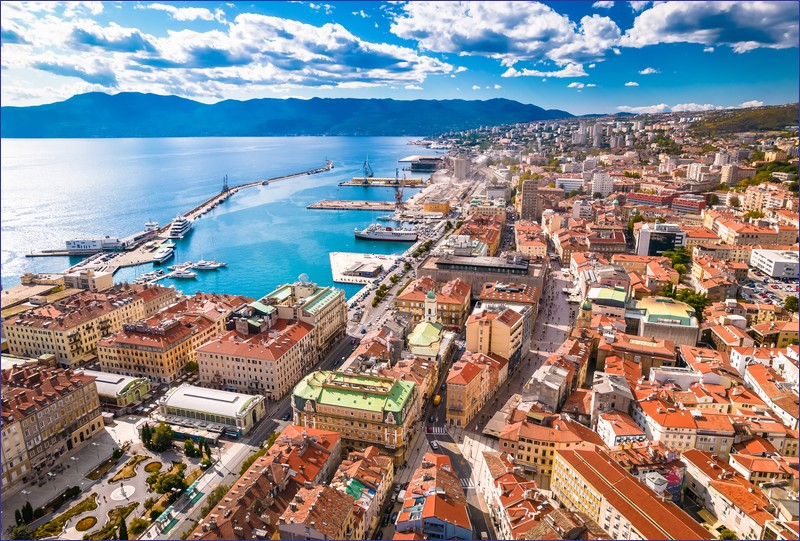The train from Warsaw to Rijeka is the biggest surprise among seasonal trains in summer 2025. For many years, there had been announcements about launching a train from Poland to Croatia. A few years ago, the Czech operator Regiojet announced a summer route from Kraków to Split, and all Polish media even published timetable. However, it ultimately turned out to be just a marketing ploy — the train never actually ran. In 2024, Regiojet cancelled also trains from Prague to Croatia.
In April 2025, Polish Prime Minister Donald Tusk announced the inauguration of a seasonal train from Warsaw to Rijeka. Many people were skeptical, but thanks to the intervention of the highest state authorities, all necessary agreements were signed in no time, and the train from Poland to Croatia appeared in the timetable. The train will run under the name Adriatic Express.
Warsaw – Rijeka – Train Schedule
The train will operate from June 27 to August 29, 2025. It is essentially a group of through carriages attached to the EC Sobieski train (classified as IC within Poland) from Warsaw to Vienna.
Adriatic Express Warsaw – Rijeka: runs on Tuesdays, Thursdays, Fridays, and Sundays
Adriatic Express Rijeka – Warsaw: runs on Mondays, Wednesdays, Fridays, and Sundays
Timetable (important stations):
Train from Warsaw to Rijeka:
Warszawa Wschodnia (departure 13:44)
Warszawa Centralna (13:50–14:05)
Warszawa Zachodnia (14:09–14:11)
Dąbrowa Górnicza (16:23–16:27)
Sosnowiec Główny (16:38–16:42)
Katowice (16:57–17:01)
Rybnik (17:48–17:50)
Tychy (17:19-17:20)
Ostrava hlavní nádraží (18:49–18:51)
Ostrava-Svinov (18:57-18:59)
Přerov (19:46–19:49)
Břeclav (20:49–20:55)
Wien Hauptbahnhof (21:49–21:55)
Wien Westbahnhof (22:30–22:45)
Graz Hauptbahnhof (2:00–2:30)
Maribor (3:31–3:38)
Celje (05:18-05:20)
Ljubljana (6:45–6:48)
Opatija Matulji (09:47-09:48)
Rijeka (arrival 10:03)
Train from Rijeka to Warsaw
Rijeka (18:15)
Opatija Matulji (18:31-18:32)
Ljubljana (22:07–22:20)
Celje (23:41-23:43)
Maribor (0:59–1:02)
Graz Hauptbahnhof (1:58–2:00)
Wien Westbahnhof (5:00–5:30)
Wien Hauptbahnhof (6:05–6:10)
Břeclav (7:04–7:09)
Přerov (8:06–8:08)
Ostrava-Svinov (08:55-08:56)
Ostrava hlavní nádraží (9:03–9:05)
Rybnik (10:11–10:14)
Katowice (11:08–11:11)
Tychy (10:43-44)
Sosnowiec Główny (11:25–11:30)
Dąbrowa Górnicza (11:40–11:41)
Warszawa Zachodnia (13:49–13:51)
Warszawa Centralna (13:55–14:10)
Warszawa Wschodnia (14:16)
There are other stops along the route allowing connections to other destinations or overnight stays for day trips.
Total journey time: ~19 hours, with plans to reduce this in coming years.
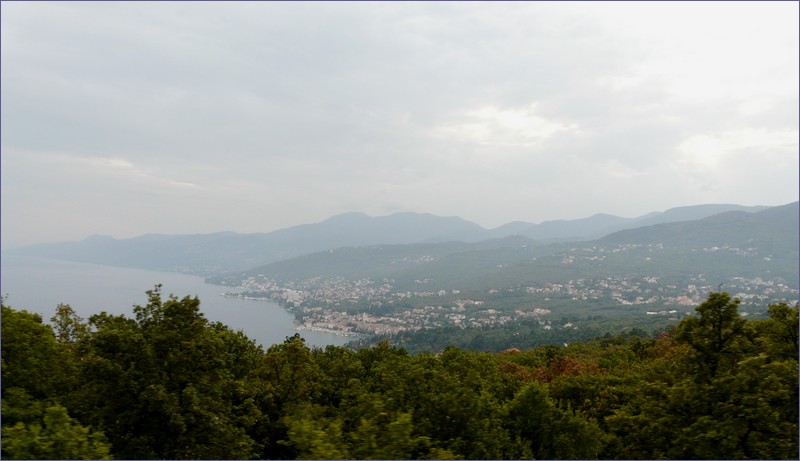
Train Composition
Available types of cars:
2 seated compartment cars
1 couchette car
A restaurant car on part of the route
Seated Cars:
Air-conditioned, 230V power sockets
Six-seat compartments
Couchette Car:
Air-conditioned, 230V power sockets
Four-person compartments
No sleeping car, which is considered the biggest downside of this connection.
Smoking is prohibited on board.
Train from Warsaw to Rijeka – ticket Prices
Ticket pricing is dynamic, meaning limited promotional fares are available first, followed by more expensive promotional tickets, and finally base fares.
Tickets are available through the PKP Intercity website. https://www.intercity.pl/
Example ticket prices Warsaw – Rijeka:
Seated car: 45,30 EUR (non-refundable), 112 EUR (flexible)
Couchette car: 70,60 EUR (non-refundable), 137,50 EUR (flexible)
Katowice – Rijeka:
Seated car: 40,35 EUR (non-refundable), 86 EUR (flexible)
Couchette car: same price as from Warsaw
Warsaw – Ljubljana:
Seated car: PLN 35 EUR (non-refundable), 112 EUR (flexible)
Couchette car: 60,52 EUR (non-refundable), 137,5 PLN (flexible)
Croatian Railways offer the cheapest seated tickets at €44.90 and couchette tickets from €66.90.
Pets
Allowed in seated cars
Dog ticket: €29 (flat fee)
In couchette car: if you want to travel with your dog, you must reserve the entire compartment
Travelling with bike
Bikes are not allowed on that train.
Pros and Cons of the Warsaw – Rijeka Train
Pros:
– Direct train access from Poland to the Adriatic coast
– Route to Rijeka (instead of Split) means fewer delays and less risk of bus replacements
– It offers easy access to Slovenia and Croatia for travelers from the Czech Republic, Slovakia, and Austria
– Good connections to Ljubljana for onward travel and tourism
Cons:
– No sleeping car (a significant drawback for families or travelers who prefer privacy and comfort)
– Journey time is long (though unavoidable given the distance)
– No direct access to Zagreb (transfer possible in Ljubljana)
– Lack of coordinated seasonal morning trains to Pula without bus transfers —a connection from Ljubljana would open the possibility of planning a round-trip: Warsaw – Ljubljana – Pula – Rijeka – Warsaw.
Travel Ideas Along the Route
Ljubljana:
Great for overnight stays and a base for train trips around Slovenia and neighboring countries. Day trips include Villach and Klagenfurt (Austria)
Trieste (Italy), Zagreb (Croatia), Koper by train and Izola – Piran by bus (Slovenia’s coastal gems), scenic railway line Jesenice → Nova Gorica (with a walking border crossing to Italian Gorizia)
Graz:
Also a great base for day train trips.
Train from Warsaw to Rijeka – most important stations:
Warsaw – visiting the capital of Poland requires at least a weekend, ideally several days. A one-day trip focuses on the area within a few kilometers of Warsaw Central Station, which offers no shortage of attractions. Walking from the station toward Śródmieście (city center), you’ll pass the Palace of Culture and Science, which includes a viewing terrace, the Museum of Evolution, and the Museum of Technology—just exploring these can take a few hours. Continue your walk through Nowy Świat and Krakowskie Przedmieście, passing landmarks like the Presidential Palace, University of Warsaw, the Visitationist Church, and St. Anne’s Church. Alternatively, head through Piłsudski Square. Either way, you’ll reach Castle Square, where you can admire the reconstructed Old Town, Royal Castle, and National Stadium from the viewing terrace. A walk through the Old Town takes about an hour. Be sure to also explore New Town and Lubelska Street.
The rest of your Warsaw visit is up to you – Łazienki Park, Praga district, or any of the many museums. For a one-day trip, it’s unlikely you’ll have time to reach Wilanów (though a 24-hour public transport ticket is recommended regardless). If I were to suggest museums specifically for a one-day visit, these would be top priority:
NBP Money Centre – an excellent museum focused on financial education and the history of money, with a large collection of coins and banknotes.
Stacja Muzeum – a must-see for railway enthusiasts; the largest railway museum in Poland, located at Warszawa Główna station, with an extensive outdoor collection of rolling stock.
Museum of Warsaw – dedicated to the city’s history, showcasing achievements and creativity of Warsaw residents in connected Old Town tenement houses.
Copernicus Science Centre – ideal for families with children. Although similar centers exist elsewhere in Poland, Warsaw’s version is unmatched.
There are also many museums dedicated to history of Poland.
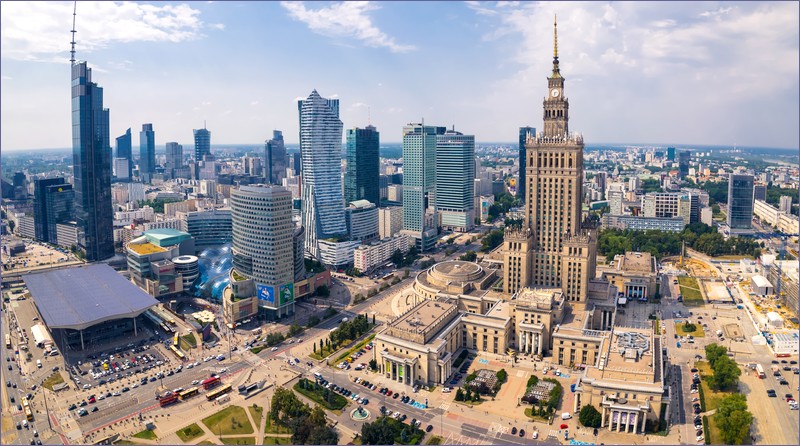
Katowice – the capital of the Silesian Voivodeship has undergone major transformation in recent decades. At first glance, it may seem like an unattractive city, but it hides many fascinating spots for curious travelers who enjoy discovering lesser-known landmarks. A typical visitor on a day trip should be sure to see the Silesian Museum, which offers a variety of thematic exhibitions about Upper Silesia, the Nikiszowiec district with its unique early 20th-century red-brick architecture, and, if time allows, Silesian Park.
The Silesian Museum is a 15-minute walk from the main train station, passing through the central square, the massive “Superjednostka” apartment block, and the iconic Spodek arena. Nikiszowiec is accessible by bus, while Silesian Park can be reached by tram.
Right next to the main station, there are also several noteworthy places: the Old Railway Station, Katowice’s first skyscraper known as Drapacz Chmur, the neglected Jewish cemetery, and the imposing Silesian Voivodeship Office building. Before taking a longer trip around the city, it’s worth learning about the history of Katowice and its various districts.
At the Katowice station you can change trains and continue your journey to Krakow.
——- Czech Republic ————-
Ostrava – one of the largest cities in the Czech Republic and an industrial center. The city is not particularly attractive in terms of architecture, but it is interesting from the perspective of the city’s and its districts’ history. In the center of Ostrava, it’s worth visiting the Ostrava Museum at Masaryk Square, housed in the Old Town Hall building. The permanent exhibitions are dedicated to the history of the city from its founding in 1267 up to 1989. Among religious landmarks, the Cathedral of the Divine Saviour, completed in 1899, stands out. A major attraction is the New Town Hall, built between 1925 and 1930 on Prokeš Square. Tourists can visit the observation tower with a viewing terrace at a height of 72 meters, offering a panorama of Ostrava. Outside the city center lies the popular Lower Vítkovice Area (Dolní oblast Vítkovice)—a large industrial complex where iron was smelted and coal was mined until recently. The 6-hectare site has been revitalized and adapted into several tourist attractions.
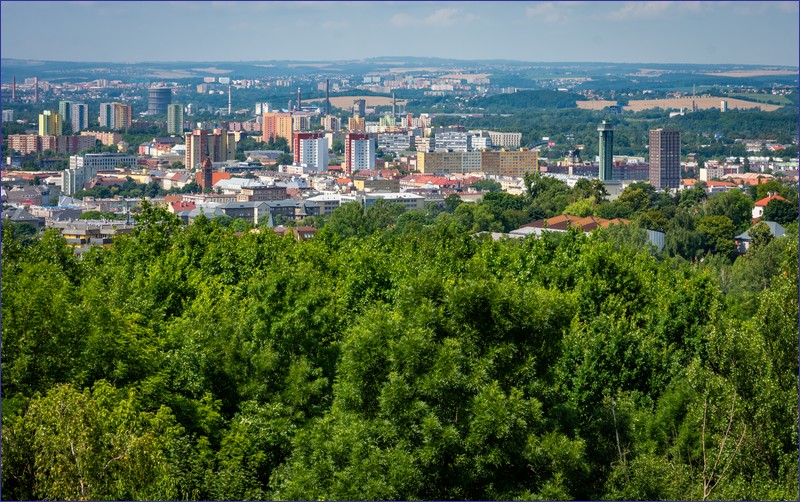
Otrokovice – a railway junction. At the station, you can transfer to a train heading to nearby Zlín, which was known as Gottwaldov between 1949 and 1989. Zlín is a medium-sized industrial city, formerly home to the Baťa shoe company, owned by Tomáš Baťa. The city was built in the functionalist style and is an excellent destination for lovers of architecture and urban planning. Noteworthy features include workers’ housing colonies, public buildings, and one of the first Czech skyscrapers, measuring 77.5 meters in height (completed in 1939). On the outskirts of Zlín, there is also a small zoo.
Staré Město u Uherského Hradiště – a railway station in the town of Staré Město. By train, you can quickly reach the charming town of Uherské Hradiště, which features two town squares and a town hall with a leaning tower. It’s also worth visiting the Slovácko Region Museum, which houses ethnographic and archaeological exhibitions. The Mařatice district is known for its wine production.
Břeclav – an important railway junction. The town is average in terms of architecture but can serve as a good base for train excursions. At Břeclav station, you can transfer to regional trains heading to Znojmo via the beautiful town of Mikulov. You can also quickly reach Brno – the second-largest city in the Czech Republic – by regional trains or numerous EuroCity trains. Trains to Bratislava also run frequently.
——— Austria ———
Vienna – Getting from Bratislava to Austria’s capital by train is quick and affordable. Vienna is home to many world-class landmarks, including Schönbrunn Palace, St. Stephen’s Cathedral, and the Hofburg Palace, once the residence of the Habsburgs. The city is renowned for its classical music heritage (Mozart, Beethoven, Strauss), art (Kunsthistorisches Museum, Albertina), and traditional coffeehouses. Most central attractions are within a 20 to 30-minute walk from Wien Hauptbahnhof, or easily accessible with a day pass for public transport, making sightseeing convenient and enjoyable.
Graz – The second-largest city in Austria and capital of Styria. A city worth visiting, and easy to explore—the main train station is about a 10–15 minute walk from the city center. The most important attraction is the Schlossberg (Castle Hill), accessible on foot via stairs or by funicular railway. On the hill, you can see the Clock Tower (Uhrturm), a remnant of the former fortress, but the beautiful city panorama is even more impressive. The vibrant Old Town is full of historic buildings with richly decorated staircases. The modern, controversial Kunsthaus Graz building is hard to miss. An ideal destination for a day trip.
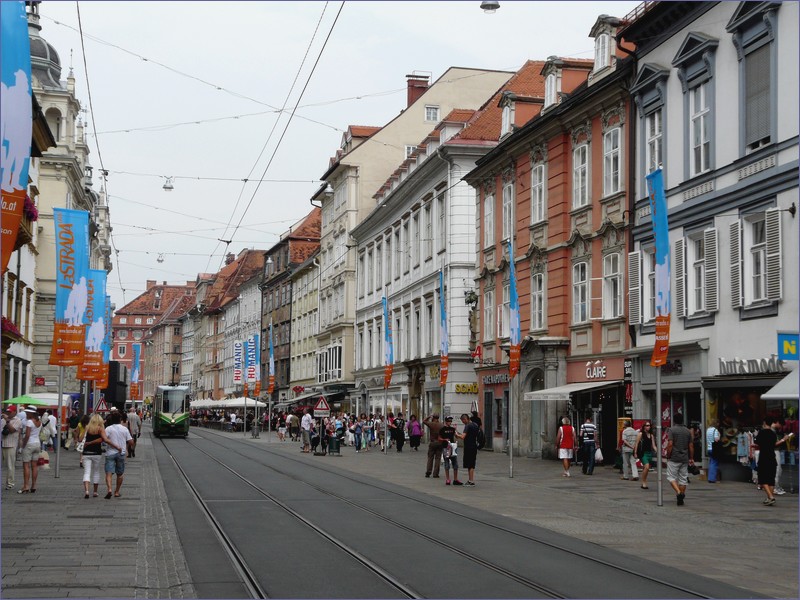
——- Slovenia ———-
Maribor – The second-largest city in Slovenia. In my opinion, it’s an average city, and it’s better to transfer here to a train heading to the picturesque Slovenian town of Ptuj. Much of Maribor’s historic architecture was destroyed during World War II. The Main Square looks nice, the world’s oldest grapevine grows in the city center, and St. John the Baptist Cathedral as well as the university building opposite are worth seeing. A quick tour of the city takes about 1.5 hours.
Celje – A medium-sized Slovenian town. The quaint center is located right next to the train station. The main attraction is the castle located on a hill a few kilometers from the center. Due to the steep climb, it takes some time to reach it.
Ljubljana – The capital of Slovenia and one of my favorite cities. Its well-kept center features many impressive buildings. The heart of Ljubljana is Prešeren Square, with a monument to France Prešeren, one of Slovenia’s greatest poets. Behind it lie the Triple Bridges, linking both sides of the river. A stroll along the river is especially enjoyable in the summer evenings, when the cafes are lively. Notable sights include St. Nicholas Cathedral, adorned with beautiful frescoes and Baroque altars, and the Dragon Bridge (Zmajski Most), famous for its dragon statues. You should also visit Ljubljana Castle (Ljubljanski grad) on a hill above the city center, accessible by funicular or on foot. The castle offers panoramic views of the city and nearby mountains. Train enthusiasts will enjoy the Railway Museum.
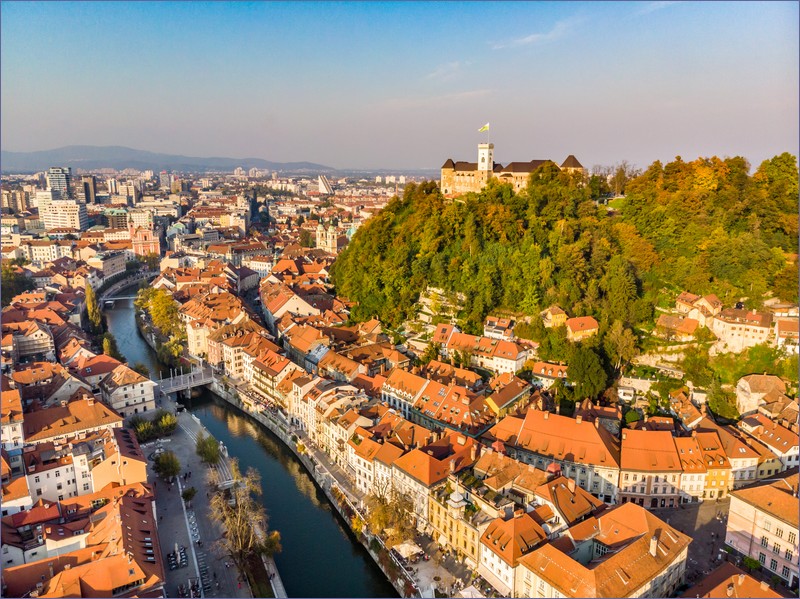
———- Croatia ——-
Rijeka – an industrial city and seaport. Rijeka is not considered one of the most beautiful cities in Croatia. A walk from the train station to the main attractions in the city center takes about 10 minutes. The Korzo, the city’s main pedestrian street lined with numerous restaurants and cafés, is particularly charming. One of the city’s symbols is the Clock Tower. Notable religious landmarks include the Baroque Cathedral of St. Vitus from the 17th century, the Church of St. Nicholas, and the Church of St. Jerome. It’s also worth visiting Trsat Castle, which overlooks the city. From the castle hill, there are beautiful panoramic views of Rijeka. The city center is home to several interesting museums, such as the City Museum, Computer Museum, Museum of Natural History, Museum of Maritime and Croatian Coastal History, and a small Pharmacy Museum.
Related articles:
Train travel in Poland – a comprehensive guide
Train travel in Croatia – a comprehensive guide
